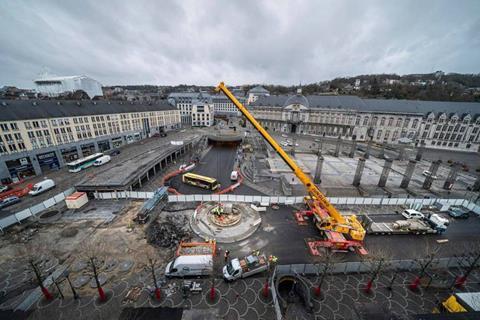
BELGIUM: Opening of the Liège tram route could be put back to January 2025 under proposals tabled by mediators appointed to review the delays and cost over-runs on the PPP-funded project.
The 11·7 km line is being built for Wallonnie public transport operator OTW by the Tram Ardent consortium of CAF, Colas Project, Colas Belgium, Colas Rail Belgium and Dutch Infrastructure Fund BV. The consortium is responsible for design, construction and financing, including the supply of 20 CAF Urbos 100 seven-module trams, followed by the maintenance of infrastructure and rolling stock until 2050.
The DBFM concession was originally valued at €550m. Under the terms of the deal, Tram Ardent would be paid availability fees of €32m/year for 31 years from the opening of the line until 2050, plus a small charge per tram-km run. This was expected to cover amortisation of the investment and the maintenance of track and vehicles. However, the later the line is completed, the less the consortium will receive.
Construction of the tram route through the medieval city has been delayed by various issues including the discovery of undocumented utilities and the Covid-19 pandemic. The opening has been put back several times, but it is now clear that the most recently announced target date of April 2024 will not be achieved. Drone footage of the works broadcast by local television company RTC on July 9 suggest that around 60% of the work has been completed so far.
Meanwhile, main contractor Colas Belgium has reported losses of up to €45m, which have been made up by a capital injection from its parent Colas, itself a subsidiary of Bouygues Construction.
Citing the delays to the project and the reduced payback period, as well as the impact of inflation, Tram Ardent has requested an increased contribution from the regional government. In February a mediator was appointed by OTW, the Wallonnie region and the consortium to review the situation and make recommendations for a revised financial settlement, as well as fixing a binding date for the start of operations.
Revised terms proposed
While the Wallonnie regional government had originally budgeted €450m to fund its share of the project, the mediator has now recommended that the region should provide an additional €79m to support the completion of the work and commissioning the tram line for operation.
This extra contribution would be dependent on a positive endorsement from the national audit office ICN before the arrangement can be formalised. The proposal is that €54m of the additional funding would be contingent on the progress of the work, with penalties envisaged if the committed dates are not achieved.
November 30 2023 has been set as a target date for restoring road traffic access to the centre of Liège. Work still to be completed includes some tracklaying and surfacing of the tram route, the planting of new trees and the installation of street furniture and lighting.
Trial running on the finished line is expected to begin by August 2024 and be completed by October, enabling testing of the trams and the operation of a full timetable without passengers during November and December of next year. This would lead to a formal opening for revenue service by January 31 2025.
State of progress
In effect the new line is a direct replacement for Liège’s original tram routes 1 to 3, which were abandoned and replaced by diesel buses in 1965-66.
However, some substantial changes to the cityscape have been needed to accommodate the largely segregated alignment which will carry the 2 650 mm wide low-floor trams. Various bus lanes have been removed, along with the former bus tunnels serving the now cut-down bus station at Place St Lambert.
The trams will share the remaining bus lane along Boulevard de Sauvenière, but elsewhere traffic lanes have been removed to make way for the tram route. Related landscape changes have included the removal by the city council of some road capacity to make more provision for pedestrians and cyclists, tree planting and green spaces.
The tramway is predicted to carry 90 000 passengers per working day, equivalent to 25% of all public transport use in Liège. Bus services are to be restructured to feed into the trams at various stops, while car users will be encouraged to patronise the park-and-ride interchanges at each end of the line.
However, questions remain about the commercial viability of the project, given the high level of car ownership in Liège (60% of all inhabitants), and the fact that many people now live in the surrounding suburbs, high above the city which lies in a deep river valley. There have been concerns that the long period of disruption during the construction phase and the permanent reduction of road space in the city centre will simply displace much of the commercial activity to out-of-town shopping centres.


